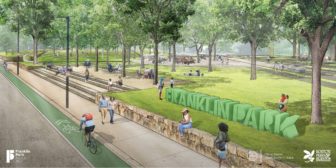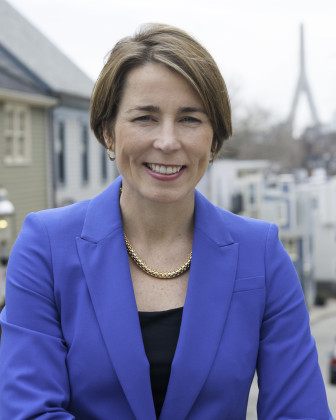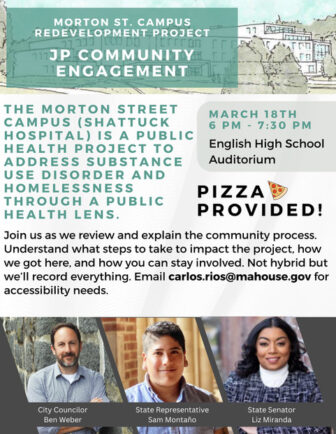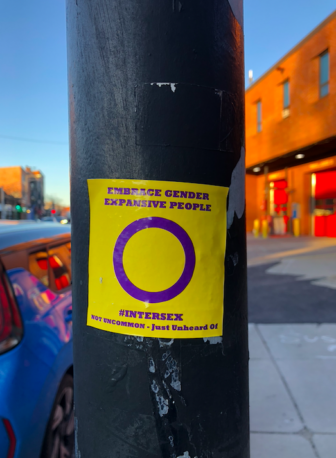Last updated on December 16, 2022
Mayor Michelle Wu announced the release of the new Franklin Park Action Plan, a 230-page report that provides a vision for the future of the 527-acre park.

Already the city wants the public to share their perspectives on the plan and community priorities among many projects related to restoring historic structures, improving access for all transportation modes, dedicated spaces for cultural and recreational purposes, and ecological considerations.
The plan can be viewed on the Franklin Park Action Plan website along with a form to capture feedback during the 60-day comment period that ends on February 10, 2023.
The plan’s recommendations include the following:
- Restoring and activating the Bear Dens with new uses;
- Reintroducing the Elma Lewis Playhouse to the Overlook with a new stage, restrooms, and seating;
- Upgrading active spaces like trails, play areas, athletic fields, and picnic sites;
- Creating a welcoming “front porch” for the Blue Hill Avenue entrance at Peabody Circle with terraced seating;
- Rehabilitating the landscape of the park by removing invasive plants, cutting back vegetation to reveal the park’s sweeping vistas, and planting new native species and trees.
The plan said that “abundant entrances” serve the Jamaica Plain community, that feed people to numerous spaces with active and passive uses, including the Playstead and White Stadium, El Parquesito Playground, Glen Road, and The Wilderness. And while the MBTA Orange Line connections including Stony Brook, Green Street, and Forest Hills Stations are all within a 15-minute walk, there is a lack of posted information about Franklin Park or how to reach it.
Speaking about Jamaica Plain, the plan said, “Pedestrian access from Jamaica Plain is easy – but only if you know where you are going. Posted signage along walking and biking routes from the Orange Line and enhanced wayfinding in The Wilderness can
improve access for new users as well.”
In regards to Circuit Drive, it cuts through the park with fast and noisy traffic that creates a divisive internal edge with “confusing intersections at Peabody Circle and the Valley Gates leave pedestrians and cyclists vulnerable and unsafe.” The plan calls to improve the external and internal roads for drivers, pedestrians and cyclists.
“Franklin Park is a treasured green space for our Boston residents and has played a crucial part in bringing our communities and neighborhoods together across generations,” said Mayor Michelle Wu. “With this Action Plan, residents and park users will have the opportunity to help the city shape the future of the park and to create a roadmap for preservation, maintenance, and public use of Olmsted’s historic landscape.”
Franklin Park has a long history of community stewardship and activism despite decades of underinvestment in the park, said the city in a press release. The action plan covers park maintenance and management, as well as cultural and recreational programming from $28 million investment, including $23 million in capital funding and a $5 million maintenance trust that was created in 2018.
“Our goal throughout the process has been to understand past planning efforts, learn what is (and isn’t) working in the park, and what park users would like to see in the future,” said Rev. Mariama White-Hammond, Chief of Environment, Energy, and Open Space for the City of Boston. “With this new funding we’re able to abandon the piecemeal approach and make a real difference for the park and the people who love it.”
“We remain committed to developing creative new opportunities for events, activities, and recreation—in partnership with the Franklin Park Coalition, Emerald Necklace Conservancy, and other local organizations,” said Ryan Woods, Commissioner of Parks and Recreation.
The city engaged with the neighborhoods that are part of/bordering Franklin Park: Dorchester, Jamaica Plain, Mattapan, Roslindale, and Roxbury. To create the plan, the city worked with numerous departments, design firms, and gathered information from more than 26,000 individuals with more than 8,000 people providing direct input.
“We believe that activity and community involvement brings more people into the park to enjoy. That’s why we are particularly interested in the restoration of the Overlook Ruins, the original site of the Playhouse in the Park created by Elma Lewis In 1966. We look forward to all of the wonderful improvements that the plan proposes,” said Rickie Thompson, President of the Franklin Park Coalition.
During the course of the three-year planning process, community members and park stakeholders identified a long list of needs and wishes for the park, and the top community priorities were:
- Elevating the standard of care across the park
- Restoration of and improvements to The Bear Dens, The Overlook, Peabody Circle, and Ellicottdale,
- Park-wide upgrades to lighting, drainage, signage, and circulation.
- Park improvements and enhanced programming have already begun with funding from the Franklin Park Endowment Trust and will be complemented with expanded capital improvements focused on community priorities.
For more information or to access the public comment form, please visit the Franklin Park Action Plan website.








